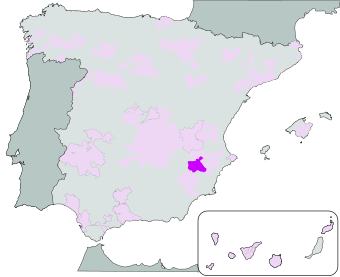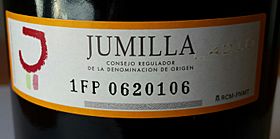Jumilla (DO) facts for kids
| Wine region | |

|
|
| Official name | D.O.P. Jumilla |
|---|---|
| Type | Denominación de Origen Protegida (DOP) |
| Year established | 1966 |
| Country | Spain |
| Climate region | Mediterranean |
| Size of planted vineyards | 18,682 hectares (46,164 acres) |
| No. of wineries | 45 |
| Wine produced | 102,637 hectolitres |
| Comments | Data for 2016 / 2017 |
Jumilla is a special area in Spain known for its wines. It is called a Denominación de Origen Protegida (DOP), which means "Protected Designation of Origin." This title ensures that wines from Jumilla meet certain quality standards and truly come from this specific region. The Jumilla DOP covers parts of the Murcia and Castile-La Mancha areas in southeastern Spain. It is named after the town of Jumilla. This region is one of the most important wine-making places in Spain.
Contents
History of Jumilla Wines
How Jumilla's Vineyards Survived a Bug Attack
In the 1800s, a tiny bug called phylloxera caused huge problems for grapevines across Europe. This bug attacked the roots of grapevines and destroyed many vineyards. Surprisingly, the Jumilla region was not affected by this bug at first. This meant that while other areas struggled, Jumilla's wine business grew a lot. Many wine merchants from France came to Jumilla to buy wine. Because of this, the grapevines in Jumilla were never changed to grow on special bug-resistant roots, unlike most other places in Europe.
The Phylloxera Bug Arrives in Jumilla
However, in 1989, the phylloxera bug finally reached Jumilla. It caused a lot of damage to the vineyards. Wine production dropped by 60% over the next five years. It was a slow and costly process to replant the vines and use the special bug-resistant roots. But this challenge also brought a chance for change. Jumilla winemakers learned new ways to grow grapes and make wine. They used successful methods from nearby wine regions like Alicante and Almansa.
Geography of the Jumilla Region
The Jumilla wine region has wide valleys and flat areas, surrounded by mountains. It is a place where the Mediterranean coast meets the high central plateau of Castile-La Mancha. This means the vineyards are at different heights, from about 400 to 800 meters above sea level.
Climate in Jumilla
Understanding Jumilla's Weather Patterns
The climate in Jumilla is mostly continental. This means it has long, hot summers and cold winters. However, being close to the Mediterranean Sea makes the weather a little milder. The area is very dry, with low rainfall, usually around 300 millimeters per year. Most of the rain falls in spring and autumn. Sometimes, there are strong storms that can harm the grapevines.
Temperatures and Sunlight for Grapes
The average temperature in Jumilla is about 16 °C (61 °F) each year. In summer, temperatures can reach 40 °C (104 °F). In winter, they can drop below 0 °C (32 °F). There is a risk of frost until March, and sometimes even until April. The grapevines in Jumilla get a lot of sunshine, more than 3,000 hours every year!
Soils of the Vineyards
The soils in Jumilla are dark and contain a lot of lime. Sometimes, they have a hard layer of lime underneath. These soils are good at letting water through and holding moisture. This helps the grapevines survive long dry periods. The soil does not have much organic material, and its structure helps prevent the phylloxera bug from spreading easily. The soil is also quite sandy, which allows for good air circulation. It has a high pH value and low salt content.
Grape Varieties Grown in Jumilla
Red Grapes of Jumilla
The main types of red grapes allowed in Jumilla are:
- Monastrell
- Tempranillo (also called Cencibel)
- Garnacha Tintorera
- Garnacha
- Cabernet Sauvignon
- Merlot
- Syrah
- Petit Verdot
White Grapes of Jumilla
The main types of white grapes allowed are:
- Airén
- Macabeo
- Chardonnay
- Sauvignon blanc
- Moscatel de Grano Menudo
- Pedro Ximénez
- Malvasía
The Importance of Monastrell Grapes
The Monastrell grape is the most important grape in Jumilla. It makes up over 85% of all the grapevines planted there. Monastrell is actually the fourth most planted red grape in all of Spain. Like the Airén grape, Monastrell is very good at resisting dry weather.
How Grapes are Planted and Harvested
For traditional planting, there are usually between 1,100 and 1,600 grapevines per hectare (about 2.5 acres). The maximum amount of red grapes allowed to be harvested is 4,000 kilograms per hectare. For white grapes, it is 4,500 kilograms per hectare. For more modern, intensive planting, there are between 1,600 and 3,200 grapevines per hectare. In this case, the maximum harvest is 7,000 kilograms per hectare for both red and white grapes.
Jumilla Wine Labels: What Do They Mean?
When you see a Spanish wine bottle, the label often tells you how long the wine has been aged. This means how long it has been kept in oak barrels or in the bottle before being sold.
- Vino Joven (or "young wine") or Sin Crianza: These wines have been aged very little, or not at all, in wooden barrels. Some are meant to be drunk very soon after they are made, perhaps within a year. Others can get better if you let them age a bit longer in the bottle.
- Vintage Year: If you see a year on the label (like "2023"), it means at least 85% of the grapes used to make that wine were harvested in that specific year.
Understanding Crianza, Reserva, and Gran Reserva
These are the three most common aging terms you will see on Spanish wine labels:
- Crianza
- Red wines: Aged for at least one year. Six months of this aging must be in oak barrels, and six months must be in the bottle.
- White and rosé wines: Aged for at least one year. Four months of this aging must be in oak barrels.
- Reserva
- Red wines: Aged for at least two years. Twelve months of this aging must be in oak barrels, and twelve months must be in the bottle.
- White and rosé wines: Aged for at least 18 months. Six months of this aging must be in oak barrels.
- Gran Reserva
- These wines are usually made in years when the grape harvest was exceptionally good.
- Red wines: Aged for at least four years. Twelve months of this aging must be in oak barrels, and a minimum of 36 months must be in the bottle.
- White and rosé wines: Aged for at least four years. Six months of this aging must be in oak barrels.
Wineries in Jumilla
There are many wineries in the Jumilla region. Here are a couple of examples:
- Monterebro: This winery was started in 1870 and was formerly known as Pedro Luis Martinez.
- Bodega Ego
See also
 In Spanish: Jumilla (vino) para niños
In Spanish: Jumilla (vino) para niños


